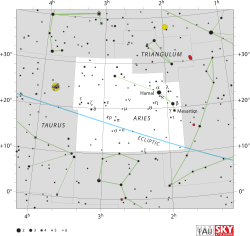Eta Arietis

Location of η Arietis (circled) | |
| Observation data Epoch J2000 Equinox J2000 | |
|---|---|
| Constellation | Aries |
| Right ascension | 02h 12m 48.08619s[1] |
| Declination | +21° 12′ 39.5839″[1] |
| Apparent magnitude (V) | 5.231[2] |
| Characteristics | |
| Spectral type | F5 V[3] |
| U−B color index | –0.04[4] |
| B−V color index | +0.44[4] |
| Astrometry | |
| Radial velocity (Rv) | +4.5[2] km/s |
| Proper motion (μ) | RA: +163.49[1] mas/yr Dec.: +5.22[1] mas/yr |
| Parallax (π) | 34.64 ± 0.33[1] mas |
| Distance | 94.2 ± 0.9 ly (28.9 ± 0.3 pc) |
| Absolute magnitude (MV) | +2.93[2] |
| Details | |
| Mass | 1.3 M☉ |
| Radius | 0.98[5] R☉ |
| Surface gravity (log g) | 4.01[3] cgs |
| Temperature | 6,380[3] K |
| Metallicity [Fe/H] | –0.35[3] dex |
| Rotational velocity (v sin i) | 9[6] km/s |
| Age | 2.6[2] Gyr |
| Other designations | |
Eta Arietis (η Ari, η Arietis) is the Bayer designation for a star in the northern constellation of Aries. It is dimly visible to the naked eye with an apparent visual magnitude of 5.231.[2] With an annual parallax shift of 34.64 mas,[1] the distance to this star is approximately 94.2 light-years (28.9 parsecs).
This is an F-type main sequence star with a stellar classification of F5 V.[3] It is younger than the Sun at an age of about 2.6 billion years.[2] The effective temperature of the outer atmosphere is 6,380 K,[3] giving it the yellow-white-hued glow of an F-type star. Eta Arietis was examined using the HARPS instrument for radial velocity variations that may be caused by an orbiting companion, but no signal was detected.[7] Nor has an infrared excess been detected using the Spitzer Space Telescope, which might otherwise indicate the presence of circumstellar gas or dust.[8]
References
- ↑ 1.0 1.1 1.2 1.3 1.4 1.5 van Leeuwen, F. (November 2007), "Validation of the new Hipparcos reduction", Astronomy and Astrophysics 474 (2): 653–664, arXiv:0708.1752, Bibcode:2007A&A...474..653V, doi:10.1051/0004-6361:20078357.
- ↑ 2.0 2.1 2.2 2.3 2.4 2.5 Holmberg, J.; Nordström, B.; Andersen, J. (July 2009), "The Geneva-Copenhagen survey of the solar neighbourhood. III. Improved distances, ages, and kinematics", Astronomy and Astrophysics 501 (3): 941–947, arXiv:0811.3982, Bibcode:2009A&A...501..941H, doi:10.1051/0004-6361/200811191.
- ↑ 3.0 3.1 3.2 3.3 3.4 3.5 Cenarro, A. J. et al. (January 2007), "Medium-resolution Isaac Newton Telescope library of empirical spectra - II. The stellar atmospheric parameters", Monthly Notices of the Royal Astronomical Society 374 (2): 664–690, arXiv:astro-ph/0611618, Bibcode:2007MNRAS.374..664C, doi:10.1111/j.1365-2966.2006.11196.x.
- ↑ 4.0 4.1 4.2 "eta Ari -- High proper-motion Star", SIMBAD Astronomical Database (Centre de Données astronomiques de Strasbourg), retrieved 2012-08-04.
- ↑ Pasinetti Fracassini, L. E. et al. (February 2001), "Catalogue of Apparent Diameters and Absolute Radii of Stars (CADARS) - Third edition - Comments and statistics", Astronomy and Astrophysics 367: 521–524, arXiv:astro-ph/0012289, Bibcode:2001A&A...367..521P, doi:10.1051/0004-6361:20000451.
- ↑ Takeda, Yoichi et al. (February 2005), "High-Dispersion Spectra Collection of Nearby F--K Stars at Okayama Astrophysical Observatory: A Basis for Spectroscopic Abundance Standards", Publications of the Astronomical Society of Japan 57 (1): 13–25, Bibcode:2005PASJ...57...13T.
- ↑ Lagrange, A.-M. et al. (February 2009), "Extrasolar planets and brown dwarfs around A-F type stars. VI. High precision RV survey of early type dwarfs with HARPS", Astronomy and Astrophysics 495 (1): 335–352, arXiv:0809.4636, Bibcode:2009A&A...495..335L, doi:10.1051/0004-6361:200810105.
- ↑ Trilling, D. E. et al. (February 2008), "Debris Disks around Sun-like Stars", The Astrophysical Journal 674 (2): 1086–1105, arXiv:0710.5498, Bibcode:2008ApJ...674.1086T, doi:10.1086/525514.
External links
| ||||||||||||||||||||||||||